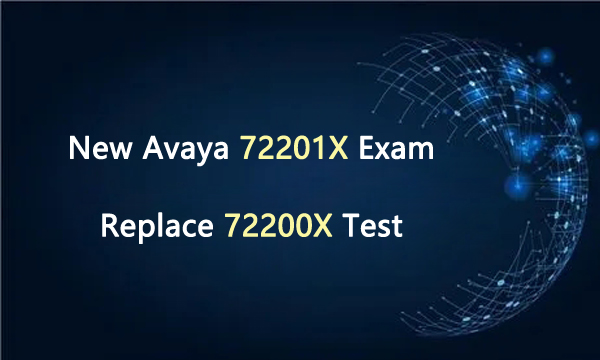New Avaya 72201X Exam Replace 72200X Test
April 14,2022 03:05 AM
News from Avaya official website, Avaya ACSS 72200X exam will be retired on April 30, 2022, and the new replacement test is 72201X Avaya Aura Core Components Support Certified Exam. To earn Avaya Aura Core Components Support (ACSS-7220) credential, you need to pass Avaya certification 72201X exam. This certification validates a candidate has achieved an advanced understanding of and competence in troubleshooting, maintaining and administration of Avaya industry leading communications products.

Avaya ACSS 72201X Exam Information
Avaya Aura Core Components Support Certified Exam 72201X information is available below.
Number of questions: 66
Duration: 105 minutes
Passing score: 68% (44 of 66 correct)
Language: English
Avaya 72201X Exam Topics
Avaya certification 72201X exam topics cover the following details.
Avaya Core Architecture
Define architectures for Avaya Aura System Manager (SMGR), Avaya Aura Session Manager (SM), Avaya Aura Communication Manager (CM), Avaya Aura Media Server (AAMS), and Avaya Aura Device Services (AADS).
Differentiate the differences and troubleshooting aspects of private versus public network environments.
Fundamental Voice Network Processes and Standards
Describe Call and Media Processing, Trust Management, and SIP Signaling.
Identify Call Routing, SMGR database Synchronization and Replication.
Define Configured Network Regions, IP Codecs and Call Admission Control (CAC)/Shared Bandwidth Management.
Describe how to view SIP Registration, Subscriptions/Notifications, PPM messages, and CM shortcuts in a SIP trace.
Avaya Aura Core Components
Describe how to identify and use the tools available for the Avaya Aura Core components.
Validate the status of CM license and synchronization, health, trunks and signaling groups, and list how to view CM certificates.
Validate AAMS various statuses, alarms, logs & monitoring capabilities.
Identify CM's Software Version, existing CM restarts, existing nodes, and perform a list trace.
Describe how to obtain an alarm report, and access CM ECS logs.
Determine SM license status, software version, and SM100 Status.
Describe Security Module detail in a SIP trace, how to download a traceSM log file, and how to view and export SM alarms, and events.
Call and Message Flows
Describe call flows for SIP-to-SIP and SIP-to-H.323 endpoints on a private network, and define a call flow for a SIP Office Worker to SIP Remote Worker.
Troubleshooting
Determine how to verify and troubleshoot current system status, validate existing configuration, verify which devices or systems are not working, and identify/resolve issue for Avaya Aura Core components.
Practice Avaya ACSS 72201X Exam Dumps
All the new cracked Avaya ACSS 72201X exam dumps are the best material for you to study Avaya Aura Core Components Support Certified Exam topics. Share some Avaya certification 72201X exam dumps questions below.
1.You are configuring Shared Bandwidth Management for Call Admission Control (CAC) between Communication Manager (CM) and Session Manager (SM). Which two tasks must you perform to achieve this? (Choose two.)
A. Match the Network Region used for the SIP users with the Domain in SM.
B. Create Locations in Session Manager.
C. Create Network Region Groups (NRG) in Communication Manager.
D. Specify the shared bandwidth limit on the Communication Manager (SIP) Entity screen.
E. Create a Bandwidth Share Group in SM.
Answer: DE
2.Which event packages would you expect to see an AST Endpoint subscribe to?
A. diag, avaya-cm-feature-status, avaya-ccs-profile, reg and message-summary
B. avaya-cm-feature-status, entity links, reg and message-summary
C. avaya-ccs-profile, network status and message-summary dialog
D. diag, avaya-cm-feature-status, avaya ccs profile and network status
E. entity links, avaya-cm-feature-status, avaya-ccs-profile and reg
Answer: A
3.When does Communication Manager insert the shortcut flag during call processing?
A. During the termination phase (imsterm) of call processing
B. During the origination phase (imsorig) of call processing
C. During the initialization phase (imsinit) of call processing
D. During the dialing analysis phase (imsdialana) of call processing
Answer: C
4.When one Avaya SIP Telephone (AST) user agent calls another AST user agent, Session Manager goes through different phases of processing the call. What is the maximum number of Phase Tags and what are they called?
A. Four – imsorig, origdone, imsterm, termdone
B. Two – origappseq and termappseq
C. Three – ingress, process, egress
D. Two – imsorig and imsterm
Answer: A
5.During Installation, through the exchange of security certificates, between which two entities does the Trust Management Service establish trust? (Choose two.)
A. Session Manager
B. Identity Management
C. System Manager
D. Communication Manager
Answer: AC
72201X Exam Dumps PDF & SOFT | 1 Year Free Update | Money Back Guarantee
72200X Exam Dumps PDF & SOFT | 1 Year Free Update | Money Back Guarantee
- Related Suggestion
- Passed 72200X with Avaya Aura Core Components Support Exam Dumps May 13,2021
- Avaya ASTA will Replace ACIS and ACSS Certifications after February 28, 2025 February 14,2025
- Avaya Messaging Support 71801X Exam Dumps Questions January 06,2023
- Actual Avaya ACSS 78950X Exam Dumps October 09,2021
- Avaya Oceana Solution Support Exam 74970X Dumps June 02,2021

